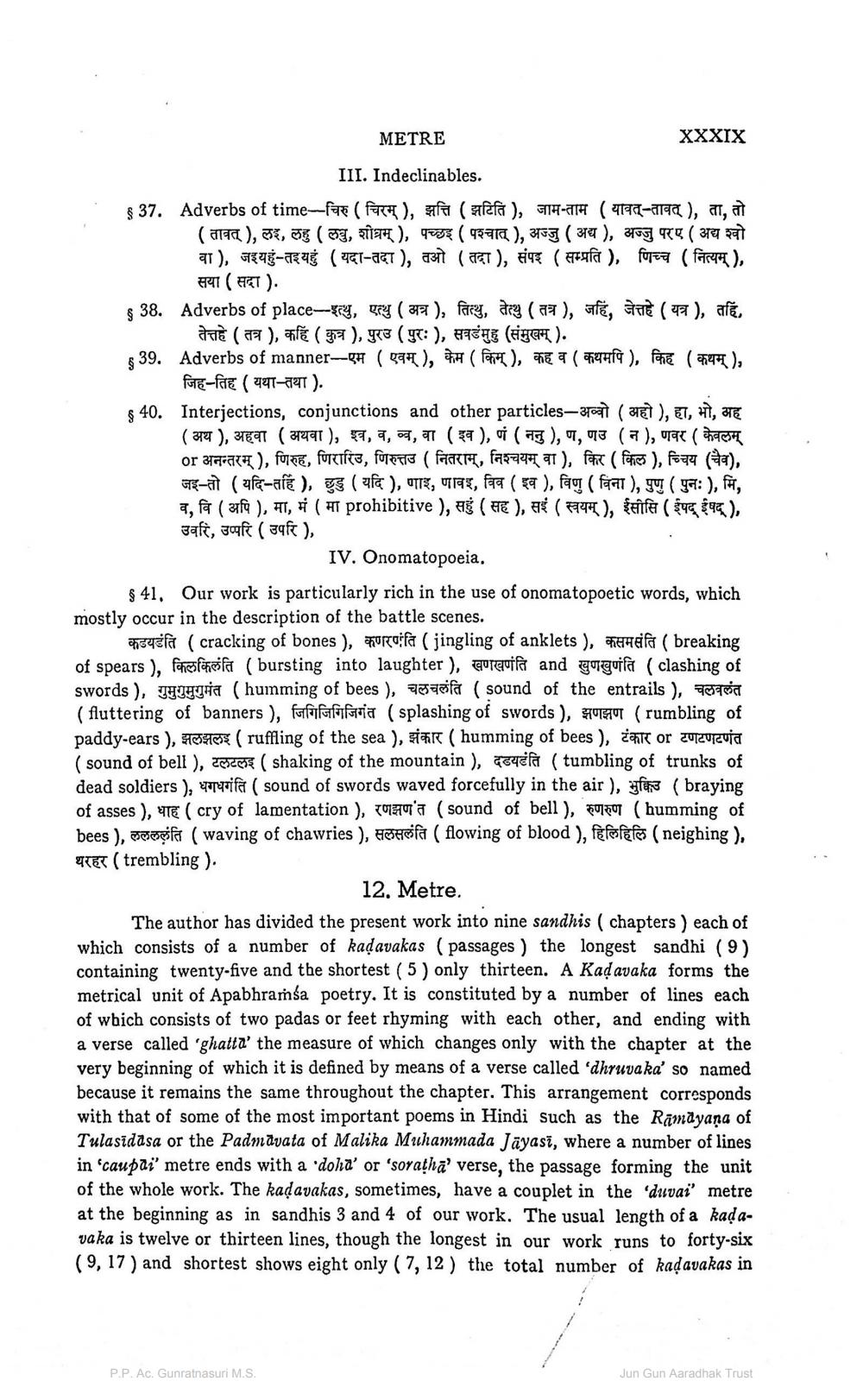________________ METRE XXXIX III. Indeclinables. 837. Adverbs of time-चिरु (चिरम् ), झत्ति (झटिति), जाम-ताम ( यावत्-तावत् ), ता, तो ( तावत् ), लइ, लहु ( लघु, शीघ्रम् ), पच्छइ ( पश्चात् ), अज्जु ( अद्य), अज्जु परए ( अद्य श्वो वा), जइयहु-तइयहूं ( यदा-तदा), तओ (तदा), संपइ (सम्प्रति ), णिच्च (नित्यम् ), सया (सदा). 838. Adverbs of place-इत्थु, एत्थु ( अत्र ), तित्थु, तेत्यु (तत्र ), जहिं, जेत्तहे ( यत्र), तहिं, तेत्तहे ( तत्र ), कहिं ( कुत्र ), पुरउ (पुरः), सवडंमुहु (संमुखम् ). 839. Adverbs of manner-एम ( एवम् ), केम (किम् ), कह व ( कथमपि), किह (कथम् ), जिह-तिह ( यथा-तथा ). 540. Interjections, conjunctions and other particles-अब्बो ( अहो), हा, भो, अह ( अथ ), अहवा (अथवा ), इव, व, ब्व, वा (इव), णं ( ननु), ण, णउ (न), णवर ( केवलम् or अनन्तरम् ), णिरुह, णिरारिउ, णिरुत्तउ (नितराम्, निश्चयम् वा), किर (किल ), च्चिय (चैव), जइ-तो (यदि-तर्हि ), छुडु ( यदि ), णाइ, णावइ, विव ( इव ), विणु ( विना), पुणु ( पुनः ), मि, व, वि ( अपि ), मा, मं ( मा prohibitive ), सहुं ( सह ), सई (स्वयम् ), ईसीसि (ईपद् ईषद् ), उवरि, उप्परि ( उपरि ), IV. Onomatopoeia. 841. Our work is particularly rich in the use of onomatopoetic words, which mostly occur in the description of the battle scenes. कडयडंति (cracking of bones), कणरणति (jingling of anklets), कसमसंति ( breaking of spears), किलकिलंति ( bursting into laughter ), खणखणंति and खुणखुणंति (clashing of swords), गुमुगुमुगुमंत ( humming of bees ), चलचलंति ( sound of the entrails ), चलवलंत (fluttering of banners), जिगिजिगिजिगत (splashing of swords), झणझण (rumbling of Daddy-ears), झलझलइ ( ruffing of the sea ), झंकार ( humming of bees), टंकार or टणटणटणंत ( sound of bell ), टलटलइ ( shaking of the mountain ), दडयदंति ( tumbling of trunks of dead soldiers), धगधगंति ( sound of swords waved forcefully in the air ), भुक्किउ ( braying of asses), धाह ( cry of lamentation ), रणझणत (sound of bell ), रुणरुण ( humming of bees ), ललललंति ( waving of chawries ), सलसलंति ( flowing of blood ), हिलिहिलि (neighing), थरहर (trembling). 12. Metre. The author has divided the present work into nine sandhis ( chapters) each of which consists of a number of kadavakas (passages) the longest sandhi (9) containing twenty-five and the shortest (5) only thirteen. A Kad avaka forms the metrical unit of Apabhramsa poetry. It is constituted by a number of lines each of which consists of two padas or feet rhyming with each other, and ending with a verse called 'ghatta' the measure of which changes only with the chapter at the very beginning of which it is defined by means of a verse called 'dhruvaka so named because it remains the same throughout the chapter. This arrangement corresponds with that of some of the most important poems in Hindi such as the Ramayana of Tulasidasa or the Padmavata of Malika Muhammada Jayasi, where a number of lines in 'caupai' metre ends with a doha' or 'soratha' verse, the passage forming the unit of the whole work. The kadavakas, sometimes, have a couplet in the duvai' metre at the beginning as in sandhis 3 and 4 of our work. The usual length of a kadavaka is twelve or thirteen lines, though the longest in our work runs to forty-six (9, 17 ) and shortest shows eight only ( 7, 12 ) the total number of kadavakas in P.P.AC.Gunratnasuri M.S. Jun Gun Aaradhak Trust




